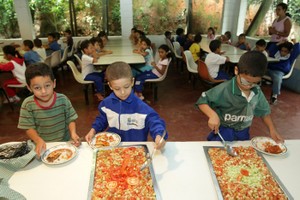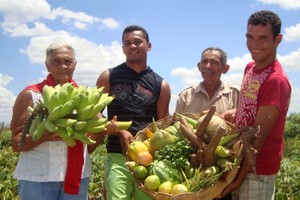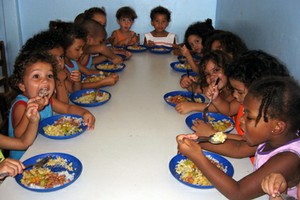Brazil has designed and implemented several highly innovative policy instruments to enhance food security. Most of these fall under the “Fome Zero” or “Zero Hunger” strategy launched in 2003, under the presidency of Mr Lula da Silva. These have drastically reduced the number of undernourished people in the country. One of the most important elements of this strategy is the PAA, or the Food Acquisition Programme. This article explains why it is so highly regarded.

The PAA started with two simultaneous objectives: increase the country’s food and nutritional security, and ensure that family farms are strengthened and gain more recognition. Set up as part of the “Zero Hunger” strategy, the PAA involves a range of parties, including the federal and the state governments, municipalities, farmers’ organisations and social service organisations.
The PAA supports family farmers by stimulating the creation of regional markets which are more suitable for small-scale producers than the regular commodity markets. Food is acquired from family farmers and used by the public sector and civil society organisations involved in social programmes (in schools or hospitals, etc.). These actors distribute the products amongst people who have difficulties in accessing food or at risk of malnutrition. Since 2003, more than 3,5 billion reais have been spent on acquiring approximately 3.1 million tonnes of food (1 real = €0.44). On average the programme involves around 160 thousand family farmers per year. The food has been distributed by about 25 thousand organisations who, in turn, reach 15 million people.
Strengthening family farming…
The PAA was established with the objective of guaranteeing access to a regular supply of high-quality food to people facing food or nutritional insecurity and to improve social inclusion in rural areas. The PAA has strengthened family farming by creating new markets and making existing ones more robust, guaranteeing sales at higher prices and promoting traditional and regional products and practices.
The programme is helping to restore or recreate a “peasant way of life”, an approach to farming that has for long been eroded by “agricultural modernisation”. Since the 1960s, farmers throughout the country have been pushed towards specialisation, monocultures and commodity production, all of which have increased their vulnerability. The PAA is stimulating a “countermovement”, helping farmers to diversify their production. The PAA purchases a diverse range of fruits, vegetables, processed goods and animal products. This has also revalorised local products which have little or no commercial value in commodity markets. Research conducted in the state of Rio Grande do Norte, for example, has shown that 42% of the participating farmers began to grow new products as a result of the programme. Such diversification has helped their incomes remain more stable, offsetting the seasonality of commodity production and the climatic, financial and other risks involved. As a result, farmers have become less vulnerable and more autonomous.
The PAA rewards farmers that work according to organic or agro-ecological production principles since these farmers conserve the natural environment and local biodiversity, use local resources, respect cultural diversity and improve local knowledge. The programme also promotes the production and distribution of the seeds of local varieties, supporting the conservation and management of agrobiodiversity.
…and enhancing food security

Farmers in PernanbucoSchool meal – girlsThe support for small-scale production goes hand in hand with stimulating the consumption of local foods. These are important in maintaining local traditions, habits and cultures that are being forgotten, or that have come to be seen as backwards.
In the north of the state of Minas Gerais, farmers’ organisations within the programme have promoted, and increased the demand for many different fruits (collectively known as frutas do Cerrado) that were unknown to the younger generation. These now provide a new source of income for many farmers.

In Tenente Portela, a municipality in the state of Rio Grande do Sul, the income generated through commercialising local products has helped farmers to restore a group of colonial mills of enormous historical and cultural value, which are now used to grind maize and wheat into flour.
The programme has provided an impetus to revitalise several other practices and regional foods in these states and throughout the rest of the country.
Equally interesting is the change in farmers’ own consumption patterns that have come about as a result of the PAA. Research carried out in different regions indicates that farmers linked to the programme have started to eat a wider variety of foods, including foods that had become less valorised or forgotten. Several schools that receive food from the PAA have drastically changed the composition of the meals they provide to their students. Students that used to receive industrial foods, such as instant soups, now find themselves eating a larger variety of high quality, fresh food during their lunch breaks. These new school meals have also increased the acceptability of “forgotten” foods amongst students who, in some cases, even began to ask for these foods at home. Studies suggest that as a result of improved school meals, children were absent less frequently and performed better.
Finally, the regional food networks created with the support of the PAA are helping “restore” the linkages between consumption and production. The relationships between consumers and producers are not confined to just financial transactions, but enable farmers and consumers to express and articulate their values and needs, and come to understand and respect those of the other stakeholders. In contrast to the main markets, dominated by large corporations, which are characterised by large distances, hierarchy, product durability and impersonality, these regional markets value seasonality, proximity, local knowledge and strong personal relations.
Developing new markets
The PAA is a new way of supporting family farming. Its distinctiveness lies in the way it directly targets the commercialisation of farmers’ produce. With the sale of part of their produce guaranteed, farmers find themselves in a stronger position in their other market relations. The PAA enables farmers to engage in new market relationships, increasing their room for manoeuvre. The programme also operates as a price-support mechanism, buying up some products when agricultural prices are low. This is enabled by a special mechanism of the PAA called “Direct Purchase”. In some cases, farmers have also been able to sell their produce before the public purchases were made. Receiving notice of the programme “coming to town”, other buyers appeared, giving farmers a better alternative.
Prior to the PAA, many farmers sold their produce exclusively to brokers, who were often the only buyers around. This created a situation of dependency, where brokers and other middlemen were able to dictate prices. With the direct purchases begun by the PAA, rural families have been able to capture a larger part of the value produced. In some areas these buyers began to offer more money to farmers. In the north of Brazil, for example, the price paid by middlemen for nuts doubled from R$ 5.00 to R$ 10.00, before reaching a peak value of R$ 18.00. Farmers have seen their incomes increase. In some cases, they have been able to give up their part-time jobs (such as labouring on large plantations) to dedicate all their time to working on their farms. Studies also point to an increase in the area that participating farmers cultivate.
The PAA has also strengthened rural areas by helping develop a type of social capital that is often lacking in these local communities. It has forged a new institutional configuration through which local communities can interact with public and civil society actors. Involving federal and local actors (including ministries, municipalities and extension services), social movements (unions, associations and co-operatives) and NGOs, these different configurations are substantially more horizontal and democratic. The flexibility of the PAA allows the institutional configurations of the regional markets to be adapted to different local/regional realities and serve different needs. And although PAA’s results have clearly been better where local organisations were more strongly involved, its presence has also triggered farmers to establish new co-operatives or associations.
The challenges ahead
There is very little doubt that the programme has achieved considerable successes, but some challenges remain. Evaluations have shown that the programme has found it difficult to address specific groups that are not well organised or that have limited access to information (such as landless farmers or indigenous groups). There are also operational and logistic problems related to the high level of bureaucracy, resulting in delays in payments and in the transport, distribution or storage of food. The programme also needs more funds to reach more family farmers and consumers. The results so far, however, show how much can be achieved with well-designed policies.
Text: Catia Grisa, Cláudia Job Schmitt, Lauro Francisco Mattei, Renato Sérgio Maluf and Sérgio Pereira Leite
Catia Grisa is currently following a PhD programme at the Rural Federal University of Rio de Janeiro (UFRRJ), looking at the public programme policies in Brazil’s rural areas.
Lecturing at different universities, Claudia Job Schmitt, Lauro Fransisco Mattei, Renato Sergio Maluf and Sergio Pereira Leite all work as researchers at the Observatory on Public Policies for Agriculture (OPPA) in Rio de Janeiro, Brazil.
